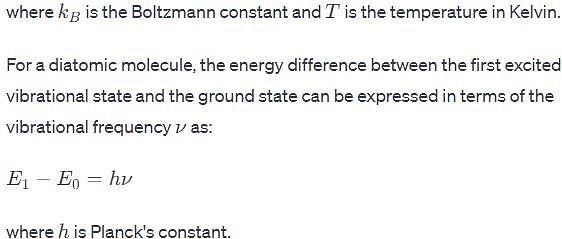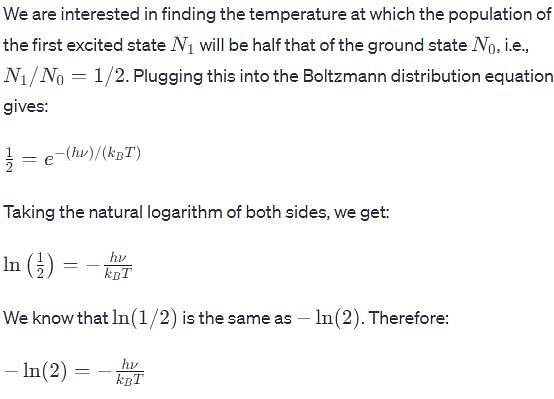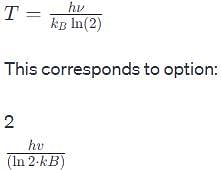Chemistry Exam > Chemistry Questions > The vibrational frequency of a homonuclear di...
Start Learning for Free
The vibrational frequency of a homonuclear diatomic molecule is v. The temperature at which the population of the first excited state will be half that of the ground state is given by.
- a)hv . ln2 / kB
- b)hv /(ln2 . kB)
- c)ln2 /( hv . kB)
- d)hv . log 2 / kB
Correct answer is option 'B'. Can you explain this answer?
| FREE This question is part of | Download PDF Attempt this Test |
Verified Answer
The vibrational frequency of a homonuclear diatomic molecule is v. The...




Most Upvoted Answer
The vibrational frequency of a homonuclear diatomic molecule is v. The...
Solution:
The energy of a homonuclear diatomic molecule is given by:
E(v) = (v + 1/2) hν
Where, v is the vibrational quantum number and h is the Planck's constant.
At a given temperature T, the population of a given vibrational level i is given by:
Ni/N0 = (gi/g0) exp(-Ei/kBT)
Where, gi and g0 are the degeneracies of the excited and ground states respectively, Ei is the energy of the excited state, and kB is the Boltzmann constant.
To find the temperature at which the population of the first excited state will be half that of the ground state, we need to solve the following equation:
N1/N0 = 1/2
(g1/g0) exp(-E1/kBT) = 1/2
Taking the natural logarithm of both sides, we get:
ln(g1/g0) - E1/kBT = ln(1/2)
ln(g1/g0) + E1/kB(T1/2) = ln(g1/g0) + E1/kBT
E1/kB(T1/2) = ln(2)
T1/2 = (ln2/kB) (E1/h)
Substituting the energy of the first excited state, E1 = 2hν, we get:
T1/2 = hv/(ln2.kB)
Therefore, the correct answer is option B.
The energy of a homonuclear diatomic molecule is given by:
E(v) = (v + 1/2) hν
Where, v is the vibrational quantum number and h is the Planck's constant.
At a given temperature T, the population of a given vibrational level i is given by:
Ni/N0 = (gi/g0) exp(-Ei/kBT)
Where, gi and g0 are the degeneracies of the excited and ground states respectively, Ei is the energy of the excited state, and kB is the Boltzmann constant.
To find the temperature at which the population of the first excited state will be half that of the ground state, we need to solve the following equation:
N1/N0 = 1/2
(g1/g0) exp(-E1/kBT) = 1/2
Taking the natural logarithm of both sides, we get:
ln(g1/g0) - E1/kBT = ln(1/2)
ln(g1/g0) + E1/kB(T1/2) = ln(g1/g0) + E1/kBT
E1/kB(T1/2) = ln(2)
T1/2 = (ln2/kB) (E1/h)
Substituting the energy of the first excited state, E1 = 2hν, we get:
T1/2 = hv/(ln2.kB)
Therefore, the correct answer is option B.
Free Test
FREE
| Start Free Test |
Community Answer
The vibrational frequency of a homonuclear diatomic molecule is v. The...
According to Boltzmann's population formula
N/n=exp(-E/kT)
As per question N=n/2 so
0.5=exp(-E/kT)
taking ln both side
ln(0.5)= -E/kT
ln(2)=hv/kT
so T=hv/(ln2.k)
where N=population in excited state
n=population in ground state

|
Explore Courses for Chemistry exam
|

|
Similar Chemistry Doubts
The vibrational frequency of a homonuclear diatomic molecule is v. The temperature at which the population of the first excited state will be half that of the ground state is given by.a)hv .ln2 / kBb)hv /(ln2 .kB)c)ln2 /( hv .kB)d)hv .log 2 / kBCorrect answer is option 'B'. Can you explain this answer?
Question Description
The vibrational frequency of a homonuclear diatomic molecule is v. The temperature at which the population of the first excited state will be half that of the ground state is given by.a)hv .ln2 / kBb)hv /(ln2 .kB)c)ln2 /( hv .kB)d)hv .log 2 / kBCorrect answer is option 'B'. Can you explain this answer? for Chemistry 2024 is part of Chemistry preparation. The Question and answers have been prepared according to the Chemistry exam syllabus. Information about The vibrational frequency of a homonuclear diatomic molecule is v. The temperature at which the population of the first excited state will be half that of the ground state is given by.a)hv .ln2 / kBb)hv /(ln2 .kB)c)ln2 /( hv .kB)d)hv .log 2 / kBCorrect answer is option 'B'. Can you explain this answer? covers all topics & solutions for Chemistry 2024 Exam. Find important definitions, questions, meanings, examples, exercises and tests below for The vibrational frequency of a homonuclear diatomic molecule is v. The temperature at which the population of the first excited state will be half that of the ground state is given by.a)hv .ln2 / kBb)hv /(ln2 .kB)c)ln2 /( hv .kB)d)hv .log 2 / kBCorrect answer is option 'B'. Can you explain this answer?.
The vibrational frequency of a homonuclear diatomic molecule is v. The temperature at which the population of the first excited state will be half that of the ground state is given by.a)hv .ln2 / kBb)hv /(ln2 .kB)c)ln2 /( hv .kB)d)hv .log 2 / kBCorrect answer is option 'B'. Can you explain this answer? for Chemistry 2024 is part of Chemistry preparation. The Question and answers have been prepared according to the Chemistry exam syllabus. Information about The vibrational frequency of a homonuclear diatomic molecule is v. The temperature at which the population of the first excited state will be half that of the ground state is given by.a)hv .ln2 / kBb)hv /(ln2 .kB)c)ln2 /( hv .kB)d)hv .log 2 / kBCorrect answer is option 'B'. Can you explain this answer? covers all topics & solutions for Chemistry 2024 Exam. Find important definitions, questions, meanings, examples, exercises and tests below for The vibrational frequency of a homonuclear diatomic molecule is v. The temperature at which the population of the first excited state will be half that of the ground state is given by.a)hv .ln2 / kBb)hv /(ln2 .kB)c)ln2 /( hv .kB)d)hv .log 2 / kBCorrect answer is option 'B'. Can you explain this answer?.
Solutions for The vibrational frequency of a homonuclear diatomic molecule is v. The temperature at which the population of the first excited state will be half that of the ground state is given by.a)hv .ln2 / kBb)hv /(ln2 .kB)c)ln2 /( hv .kB)d)hv .log 2 / kBCorrect answer is option 'B'. Can you explain this answer? in English & in Hindi are available as part of our courses for Chemistry.
Download more important topics, notes, lectures and mock test series for Chemistry Exam by signing up for free.
Here you can find the meaning of The vibrational frequency of a homonuclear diatomic molecule is v. The temperature at which the population of the first excited state will be half that of the ground state is given by.a)hv .ln2 / kBb)hv /(ln2 .kB)c)ln2 /( hv .kB)d)hv .log 2 / kBCorrect answer is option 'B'. Can you explain this answer? defined & explained in the simplest way possible. Besides giving the explanation of
The vibrational frequency of a homonuclear diatomic molecule is v. The temperature at which the population of the first excited state will be half that of the ground state is given by.a)hv .ln2 / kBb)hv /(ln2 .kB)c)ln2 /( hv .kB)d)hv .log 2 / kBCorrect answer is option 'B'. Can you explain this answer?, a detailed solution for The vibrational frequency of a homonuclear diatomic molecule is v. The temperature at which the population of the first excited state will be half that of the ground state is given by.a)hv .ln2 / kBb)hv /(ln2 .kB)c)ln2 /( hv .kB)d)hv .log 2 / kBCorrect answer is option 'B'. Can you explain this answer? has been provided alongside types of The vibrational frequency of a homonuclear diatomic molecule is v. The temperature at which the population of the first excited state will be half that of the ground state is given by.a)hv .ln2 / kBb)hv /(ln2 .kB)c)ln2 /( hv .kB)d)hv .log 2 / kBCorrect answer is option 'B'. Can you explain this answer? theory, EduRev gives you an
ample number of questions to practice The vibrational frequency of a homonuclear diatomic molecule is v. The temperature at which the population of the first excited state will be half that of the ground state is given by.a)hv .ln2 / kBb)hv /(ln2 .kB)c)ln2 /( hv .kB)d)hv .log 2 / kBCorrect answer is option 'B'. Can you explain this answer? tests, examples and also practice Chemistry tests.

|
Explore Courses for Chemistry exam
|

|
Suggested Free Tests
Signup for Free!
Signup to see your scores go up within 7 days! Learn & Practice with 1000+ FREE Notes, Videos & Tests.


















